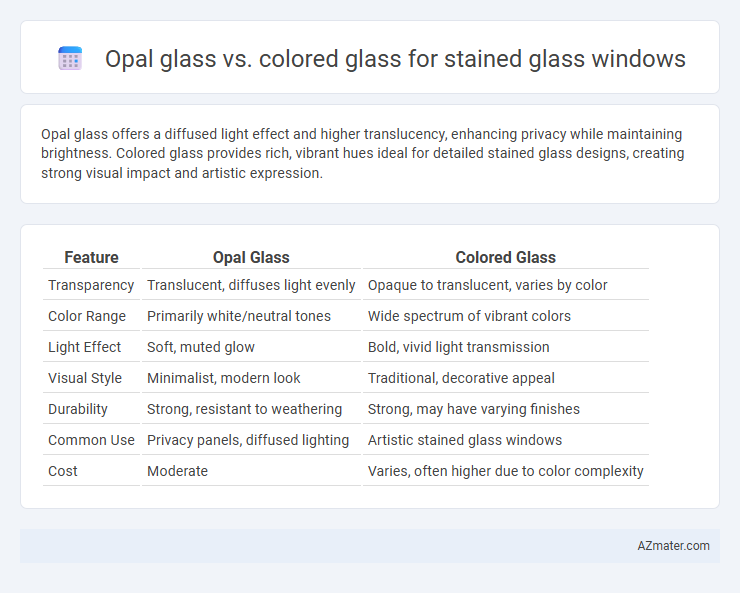Opal glass offers a diffused light effect and higher translucency, enhancing privacy while maintaining brightness. Colored glass provides rich, vibrant hues ideal for detailed stained glass designs, creating strong visual impact and artistic expression.
Table of Comparison
| Feature | Opal Glass | Colored Glass |
|---|---|---|
| Transparency | Translucent, diffuses light evenly | Opaque to translucent, varies by color |
| Color Range | Primarily white/neutral tones | Wide spectrum of vibrant colors |
| Light Effect | Soft, muted glow | Bold, vivid light transmission |
| Visual Style | Minimalist, modern look | Traditional, decorative appeal |
| Durability | Strong, resistant to weathering | Strong, may have varying finishes |
| Common Use | Privacy panels, diffused lighting | Artistic stained glass windows |
| Cost | Moderate | Varies, often higher due to color complexity |
Introduction to Opal Glass and Colored Glass
Opal glass features a translucent, milky-white appearance that diffuses light evenly, making it ideal for stained glass windows requiring soft illumination and subtle color transitions. Colored glass is available in a wide spectrum of vibrant hues, providing bold, rich colors that create striking visual contrasts and detailed designs. Both materials are essential in stained glass artistry, with opal glass offering gentle luminosity and colored glass delivering intense color saturation.
Key Characteristics of Opal Glass
Opal glass is prized for its milky, translucent quality that diffuses light softly and evenly, creating a luminous, glowing effect ideal for stained glass windows. Unlike colored glass, which offers rich, vibrant hues, opal glass provides a neutral base that enhances the interplay of light without overwhelming color intensity. Its smooth texture and consistent opacity make it a preferred choice for intricate designs requiring subtle light modulation and visual depth.
Defining Features of Colored Glass
Colored glass for stained glass windows is characterized by its rich, vibrant hues achieved through adding various metal oxides or minerals during production, offering a broad palette from deep reds to vivid blues. Unlike opal glass, which is typically milky and translucent, colored glass provides a more intense color saturation and greater light transmission, enhancing intricate artistic designs. The glass's ability to vary in opacity and texture allows artists to create dynamic visual effects, essential for traditional stained glass artistry.
Color and Light Transmission Differences
Opal glass exhibits a milky, translucent quality that diffuses light evenly, creating a soft, glowing effect ideal for subtle color gradations in stained glass windows. Colored glass, in contrast, offers vibrant and saturated hues due to its higher transparency, allowing more direct light transmission and distinct color brilliance. The choice between opal and colored glass significantly impacts the visual dynamics and atmosphere of stained glass art through their differing interactions with light and color intensity.
Durability and Maintenance Comparison
Opal glass offers superior durability in stained glass windows due to its uniform thickness and resistance to cracks, reducing the need for frequent repairs compared to colored glass. Colored glass, while vibrant and traditional, is more prone to fading and surface damage from environmental factors, increasing maintenance demands. Regular cleaning for both types is essential, but opal glass typically requires less upkeep, making it a practical choice for long-lasting stained glass installations.
Aesthetic Appeal in Stained Glass Windows
Opal glass offers a smooth, milky translucence that diffuses light evenly, creating a soft, ethereal glow ideal for enhancing intricate stained glass designs. Colored glass provides vibrant hues and intense saturation, allowing for bold contrasts and dynamic visual storytelling in windows. The choice between opal and colored glass significantly impacts the window's mood and depth, with opal glass favoring subtle elegance and colored glass emphasizing vivid artistic expression.
Suitability for Different Design Styles
Opal glass offers a smooth, milky translucency ideal for modern and minimalist stained glass window designs, enhancing soft light diffusion and subtle color palettes. Colored glass features vibrant hues and varied textures, making it more suitable for traditional, Gothic, or Art Nouveau styles where intricate patterns and bold contrasts are essential. Selecting between opal and colored glass depends on the desired aesthetic impact, with opal lending elegance to contemporary settings and colored glass providing dynamic visual storytelling in classic designs.
Cost Considerations and Budget Impact
Opal glass for stained glass windows typically incurs higher costs due to its opaque quality and the need for specialized manufacturing techniques, which impact overall budget allocation. Colored glass offers a more budget-friendly alternative, with a wide range of hues produced efficiently and at lower prices, making it suitable for larger projects with cost constraints. Project planners must weigh the aesthetic benefits of opal glass against the more economical versatility of colored glass to optimize financial resources effectively.
Installation and Crafting Challenges
Opal glass offers milky translucency ideal for diffused light effects but poses challenges in cutting due to its inconsistent opacity and brittleness, requiring precise tooling and handling techniques. Colored glass, prized for its vibrant hues and light transmission, demands careful selection of matching color batches and meticulous grinding to fit complex patterns, increasing crafting time. Installation of opal glass necessitates reinforced frames to support its weight without stress fractures, while colored glass panels often require lead came or copper foil methods to accommodate their varied thickness and ensure long-term stability.
Choosing the Right Glass for Your Stained Glass Project
Opal glass offers a translucent, milky appearance that diffuses light softly, making it ideal for achieving a subtle glow in stained glass windows. Colored glass provides a vibrant spectrum of hues and textures, allowing for more detailed and expressive designs with rich color saturation. Selecting the right glass depends on the desired light effect and artistic style, with opal glass enhancing ambient light and colored glass creating bold, eye-catching visuals.

Infographic: Opal glass vs Colored glass for Stained glass window
 azmater.com
azmater.com